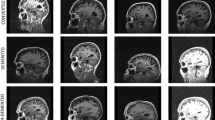Abstract
Advances in neural networks and deep learning have opened a new era in medical imaging technology, health care data analysis and clinical diagnosis. This paper focuses on the classification of MRI for diagnosis of early and progressive dementia using transfer learning architectures that employ Convolutional Neural Networks-CNNs, as a base model, and fully connected layers of Softmax functions or Support Vector Machines-SVMs. The diagnostic process is based on the analysis of the neurodegenerative changes in the brain using segmented images of brain asymmetry, which has been identified as a predictive imaging source of early dementia. Results from 300 independent simulation runs on a set of four binary and one multiclass MRI classification tasks illustrate that transfer learning of CNN-based models equipped with SVM output layer is capable to produce better performing models within a few training epochs compared to commonly used transfer learning architectures that combine CNN pretrained models with fully connected Softmax layers. However, experimental findings also confirm that longer training sessions appear to compensate for the shortcomings of the fully connected Softmax layers in the long term. Diagnosis of early dementia on unseen patients’ brain asymmetry MRI data reached an average accuracy of 90.25% with both transfer learning architectures, while progressive dementia was promptly diagnosed with an accuracy that reached 95.90% using a transfer learning architecture that has the SVM layer.
Access this chapter
Tax calculation will be finalised at checkout
Purchases are for personal use only
Similar content being viewed by others
References
Zhang, Z., **e, Y., **ng, F., McGough, M., Yang, L.: MDNet: a semantically and visually interpretable medical image diagnosis network. In: Proceedings of the IEEE Conference on Computer Vision and Pattern Recognition, Honolulu, Hawaii, USA, pp. 6428–6436. IEEE (2017)
Segato, A., Marzullo, A., Calimeri, F., De Momi, E.: Artificial intelligence for brain diseases: a systematic review. APL Bioeng. 4(4), 041503 (2020)
Janelidze, M., Botchorishvili, N.: Mild cognitive impairment. In: Alzheimer’s Disease: The 21st Century Challenge, vol. 91. IntechOpen, London (2018)
Yang, C., Zhong, S., Zhou, X., Wei, L., Wang, L., Nie, S.: The abnormality of topological asymmetry between hemispheric brain white matter networks in Alzheimer’s disease and mild cognitive impairment. Front. Aging Neurosci. 9, 261 (2017)
Liu, H., et al.: Changes in brain lateralization in patients with mild cognitive impairment and Alzheimer’s disease: a resting-state functional magnetic resonance study from Alzheimer’s disease neuroimaging initiative. Front. Neurol. 9, 3 (2018)
Herzog, N.J., Magoulas, G.D.: Brain asymmetry detection and machine learning classification for diagnosis of early dementia. Sensors 21(3), 778 (2021)
Lundervold, A.S., Lundervold, A.: An overview of deep learning in medical imaging focusing on MRI. Z. Med. Phys. 29(2), 102–127 (2019)
Yamanakkanavar, N., Choi, J.Y., Lee, B.: MRI segmentation and classification of human brain using deep learning for diagnosis of Alzheimer’s disease: a survey. Sensors 20(11), 3243 (2020)
Alom, M.Z., et al.: The history began from alexnet: a comprehensive survey on deep learning approaches. ar**v:1803.01164 (2018)
Tajbakhsh, N., et al.: Convolutional neural networks for medical image analysis: full training or fine tuning? IEEE Trans. Med. Imaging 35(5), 1299–1312 (2016)
Tang, Y.: Deep learning using linear support vector machines. ar**v:1306.0239 (2013)
Yamashita, R., Nishio, M., Do, R.K.G., Togashi, K.: Convolutional neural networks: an overview and application in radiology. Insights Imaging 9(4), 611–629 (2018). https://doi.org/10.1007/s13244-018-0639-9
Basaia, S., et al.: Alzheimer’s disease neuroimaging initiative: automated classification of Alzheimer’s disease and mild cognitive impairment using a single MRI and deep neural networks. NeuroImage Clin. 21, 101645 (2019)
Stamate, D., et al.: Applying deep learning to predicting dementia and mild cognitive impairment. In: Maglogiannis, I., Iliadis, L., Pimenidis, E. (eds.) AIAI 2020. IAICT, vol. 584, pp. 308–319. Springer, Cham (2020). https://doi.org/10.1007/978-3-030-49186-4_26
Johansen, A.M., Evers, L., Whiteley, N.: Monte Carlo Methods. Lecture Notes, p. 200 (2010)
Lama, R.K., Gwak, J., Park, J.S., Lee, S.W.: Diagnosis of Alzheimer’s disease based on structural MRI images using a regularized extreme learning machine and PCA features. J. Healthc. Eng. 2017(1), 1–11 (2017)
Abdi, H., Williams, L.J.: Principal component analysis. WIREs Comp. Stats. 2(4), 433–459 (2010)
Ding, S., Xu, X., Nie, R.: Extreme learning machine and its applications. Neural Comput. Appl. 25(3–4), 549–556 (2013). https://doi.org/10.1007/s00521-013-1522-8
Khairandish, M.O., Gurta, R., Sharma, M.: A hybrid model of faster R-CNN and SVM for tumor detection and classification of MRI brain images. Int. J. Mech. Prod. Eng. Res. Dev. 10(3), 6863–6876 (2020)
Singh, S.A., Majumder, S.: Short and noisy electrocardiogram classification based on deep learning. In: Deep Learning for Data Analytics, pp. 1–19. Academic Press, Cambridge (2020)
Yadav, S.S., Jadhav, S.M.: Deep convolutional neural network based medical image classification for disease diagnosis. J. Big Data 6(1), 1–18 (2019). https://doi.org/10.1186/s40537-019-0276-2
Krizhevsky, A., Sutskever, I., Hinton, G.E.: ImageNet classification with deep convolutional neural networks. Commun. ACM 60(6), 84–90 (2017)
Strongman, H., et al.: Limitations for health research with restricted data collection from UK primary care. Pharmacoepidemiol. Drug Saf. 28(6), 777–787 (2019)
Author information
Authors and Affiliations
Corresponding author
Editor information
Editors and Affiliations
Rights and permissions
Copyright information
© 2021 The Author(s), under exclusive license to Springer Nature Switzerland AG
About this paper
Cite this paper
Herzog, N.J., Magoulas, G.D. (2021). Deep Learning of Brain Asymmetry Images and Transfer Learning for Early Diagnosis of Dementia. In: Iliadis, L., Macintyre, J., Jayne, C., Pimenidis, E. (eds) Proceedings of the 22nd Engineering Applications of Neural Networks Conference. EANN 2021. Proceedings of the International Neural Networks Society, vol 3. Springer, Cham. https://doi.org/10.1007/978-3-030-80568-5_5
Download citation
DOI: https://doi.org/10.1007/978-3-030-80568-5_5
Published:
Publisher Name: Springer, Cham
Print ISBN: 978-3-030-80567-8
Online ISBN: 978-3-030-80568-5
eBook Packages: Intelligent Technologies and RoboticsIntelligent Technologies and Robotics (R0)




